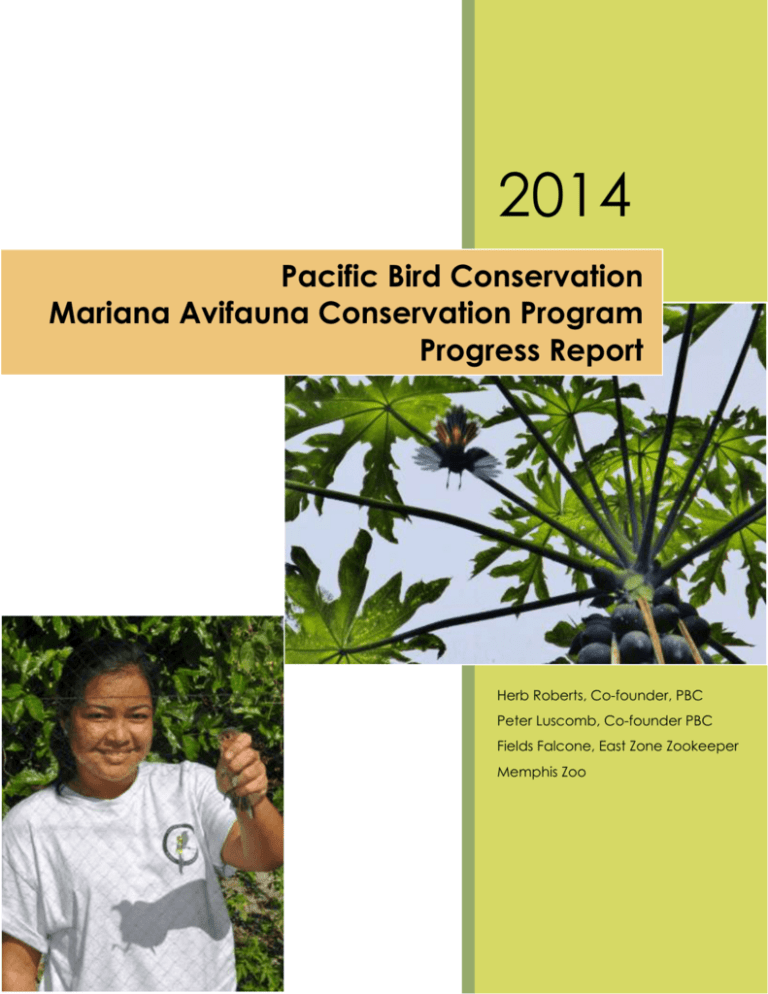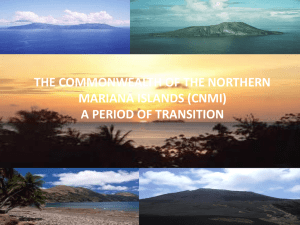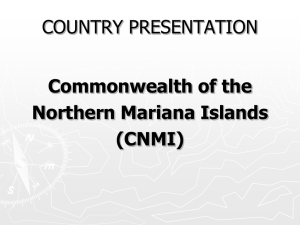File - Pacific Bird Conservation
advertisement

2014 Pacific Bird Conservation Mariana Avifauna Conservation Program Progress Report Herb Roberts, Co-founder, PBC Peter Luscomb, Co-founder PBC Fields Falcone, East Zone Zookeeper Memphis Zoo 30 May 2014 1 Pacific Bird Conservation, MAC Program 2014 Progress Report for MAC 2014 Phase One 1. Title of Project: Translocation of the Tinian Monarch: Mariana Avifauna Conservation Program, Phase Nine 2. Investigators / Institutions: Herb Roberts, Pacific Bird Conservation. Peter Luscomb, Pacific Bird Conservation. Paul Radley, CNMI Division of Fish and Wildlife. 3. Date of Report: 30 May 2014 4. Start Date / End Date: 15 May 2013 / 15 May 2014 5. Summary of progress to date as related to each of the original objectives: Background The island of Guam’s avifauna rapidly disappeared with the introduction of the non-native brown treesnake in the last half of the twentieth century. The snake is believed to be solely responsible for the extirpation or severe reduction of Guam’s 25 bird species; based on roadside surveys conducted on Guam over a 20 year period, most species experienced a 90% decline in less than a decade (Jaffe 1994, Fritz and Rodda 1998). The islands of Saipan, Tinian, and Rota, part of the Commonwealth of the Northern Mariana Islands (CNMI), are all close neighbors to Guam, and together comprise the Mariana Islands archipelago. Their avifaunae are recognized as having the greatest risk from introduction of the brown treesnake (DFW 2005). The snake has been observed on all three islands (Hawley 2003). The Northern Marianas forest birds have limited distributions, and most species are found only in the CNMI. Several species have extremely limited ranges such as the Tinian monarch (Monarcha takatsukasae), found only on Tinian; the golden white-eye (Cleptornis marchei), found only on Saipan and Aguiguan; the nightingale reed-warbler (Acrocephalus luscinia) found only on Saipan and Alamagan; and the Mariana fruit dove (Ptilinopus roseicapilla), found only on four CNMI islands, on some numbering less than ten. The CNMI government has requested long-term assistance of the Memphis Zoo and other AZA institutions to aid with the following objectives: 2 Pacific Bird Conservation, MAC Program 2014 Develop techniques to capture, acclimate to captive conditions, hold, transport, and breed in captivity all of the bird species found in CNMI, Establish captive populations of select species that can be used as a source population for possible reintroduction back to Guam or islands in the CNMI which are able to control the brown treesnake, Translocate birds to islands where the brown tree snake is not present, Develop public education programs that will assist the conservation of their avifauna, Develop fund raising program to assist in situ conservation efforts, and Provide training to local biologists upon request. The Mariana Avifauna Conservation (MAC) Program, a partnership with the CNMI Division of Fish and Wildlife (DFW), Pacific Bird Conservation (PBC), and annually over a dozen Association of Zoos and Aquariums (AZA)-accredited zoos, has been spearheading this conservation mission for nine years. Updated Main Objectives for 2013-14 This year’s field work took place from 7 April to 3 May 2014. The main objectives were the following: 1. Translocation: Tinian monarchs (goal: 50) would be moved from the source island Tinian, where the snake poses a threat, to the sanctuary island Guguan 2. AZA population augmentation: Tinian monarchs and Mariana fruit doves would be brought from Tinian into AZA zoos, numbers to be determined by resources available. Conservation reserve islands such as Guguan have been chosen by DFW biologists because they are uninhabited and share the same forest composition as the source islands Saipan, Tinian, and Rota. The MAC Plan (MAC Working Group 2013) outlines avian translocation plans from source to sanctuary islands through 2032, as agreed upon by AZA participants, Pacific Bird Conservation, the US Fish and Wildlife Service, and the CNMI DFW. These plans involve multiple years of moving source populations to specific reserve islands to avoid inter-specific competition. Tinian monarchs long-term are slated for Guguan rather than Sarigan, where previous translocations have already taken place (Radley 2008, 2009, 2012, 2013), in order to avoid potential resource competition with golden white-eyes (MAC Working Group 2013). Unfortunately, the distance from Tinian to Guguan (160 mi) was not tenable by helicopter this year because of low fuel reserves along the route – this distance requires a re-fueling midpassage, and reserves were used by another government organization about a month prior to our arrival in the CNMI for this year’s field work. Because of this, new plans for the 2013-14 field season had to be quickly implemented. Two teams would operate separate missions on two different islands, a first for the MAC Program. Peter Luscomb (Honolulu Zoo [retired]/Pacific Bird Conservation) would head up field and husbandry objectives on Tinian, and Herb Roberts (Memphis Zoo/Pacific Bird Conservation) would lead his own team on Saipan. The primary objectives were changed in March 2014 to the following: 3 Pacific Bird Conservation, MAC Program 2014 1. Translocation: Rufous fantails (Rhipidura rufifrons) (goal: 48) would be captured on Tinian and moved to Sarigan (distance 118 mi), which would not require a re-fueling. This objective was slated for 2016 to complement the fantail translocation of 2013 and bring total translocated fantails up to approximately 80. This goal was surpassed with a total of 51 rufous fantails (title page, Figure 1) successfully released on Sarigan. 2. AZA population augmentation: Because Tinian monarchs were not going to be kept in holding for translocation, it was less feasible to hold both monarchs for zoos and fantails for translocation, as well as Mariana fruit doves for zoos. AZA zoo captive program augmentation target species were changed to Mariana fruit doves and golden white-eyes captured on Saipan rather than Tinian, as both of these programs were also in need of an infusion, and capture sites were well known from previous years on Saipan. A total of 20 golden white-eyes (Figure 2) and 12 Mariana fruit doves (Figure 3) were captured on Saipan and brought into the US, and are currently being moved to participating AZA zoos. Figures 1-3. A rufous fantail being extracted from the mist net, a golden white-eye in the hand, and a Mariana fruit dove safely extracted in the field for the MAC Program on Tinian and Saipan, CNMI, 2014. 4 Pacific Bird Conservation, MAC Program 2014 Methods and Results for Main Objectives The 2014 team consisted of 18 participants from 12 AZA zoological institutions, and included directors, curators, team leaders, keepers, and veterinarians, as well as the CNMI intern. While the target bird species technically breed year round as this is a tropical island ecosystem, the translocations are purposely planned at the end of the dry season, when the insectivores and frugivores are typically finished with the main spring pulse of breeding, in order to avoid interrupting this cycle. In 2014 we did find one active Tinian monarch nest, and observed several pairs of fantails and monarchs feeding fledglings. On Tinian, we used the same general location for netting that was accessed in previous years of Tinian monarch collection. These were located at the north end of the island off old World War II airplane runways. Mist nets (Figure 1), very fine fabric nets specifically designed to capture avifauna safely, were erected on poles in suitable habitat where target birds were heard and seen, and unproductive nets were relocated as needed. Net locations were determined by observing the foraging and movement of target species and setting up nets along forest edges and within the forest in natural openings to minimize manual clearing. A small mesh size (24 mm) was used for Tinian monarch and rufous fantail capture. A total of 130 birds were netted on Tinian (Table 1). Rufous fantails, the primary targeted species, were the most numerous species captured. Some of these birds were released in the field if they did not respond well to being in the holding crates, an indication that they would not be good candidates for the translocation process. A total of 51 fantails were held for translocation. Tinian monarchs were the second most numerous species, and a subset were held for fecal collections (Figure 4). Incidental captures (non-targeted species) included bridled white-eyes and Micronesian honeyeaters. The higher net numbers indicate nets that were set up later during the week of trapping. At any given time there were approximately 8 nets in operation, depending on their fantail capture productivity. On Saipan, we returned to field sites we secured permission to use in previous years with the help of CNMI DFW. When targeting doves, a larger mist net mesh size (60 mm) was used to minimize incidental captures of smaller birds, while a smaller mesh size (30 mm) was used to target golden white-eyes. Capture data from Saipan are still pending, as the Saipan field team leader continued on to Guam for another conservation project through mid-May. Over the years Peter Luscomb has developed holding and transport boxes customized for individual bird species. Rufous fantails, golden white-eyes, and Mariana fruit doves all exhibit less behavioral stress if held in individual accommodations rather than being housed together. Three husbandry shifts daily were required to care for the animals while in holding. Rufous fantails on Tinian transitioned successfully from a diet of flies that were cultivated using rotting fish to sedentary mealworms shipped in for the study. This dietary transitioning from flying to sedentary prey bodes well for future attempts to bring more of this species into zoo assurance colonies. Doves on Saipan were hand-fed a weaning formula to insure weights were maintained prior to transport. Golden white-eyes on Saipan were fed a combination of mealworms and fresh fruit. All birds were tested for parasites, weights checked daily, and data were taken on several measurements such as fat stores, body condition, wing cord, tail length, and tarsus length as 5 Pacific Bird Conservation, MAC Program 2014 needed for each species. Each rufous fantail was marked in the field with a unique MAC aluminum numbered leg band, and birds designated for translocation were given a unique combination of three color bands the night before release, two on the right leg and one coupled with the aluminum band on the left, to allow for identification in the field during future CNMI DFW surveys (Figure 5). An exciting methodological addition was the surgical sexing via laparoscopy of Mariana fruit doves by Disney veterinarian Dr. Deidre Fontenot. Females were of primary importance for AZA captive populations, and 7 of the 12 doves captured were determined to be female. In previous years, blood samples were rushed but often data were not received before translocation or transport. Morphological measurements can be used to estimate sex ratios, but the relatively non-invasive procedure used this year will greatly aid in appropriate designation of birds for zoo captive programs. On 21 April 2014 the rufous fantails were flown from Tinian to Sarigan via helicopter and successfully released (Figures 6-8). All 51 birds left their transport crates quickly and on the wing. On 3 May 2014, despite a close brush with Typhoon Tapah, the 20 golden white-eyes and 12 Mariana fruit doves were escorted by MAC staff on chartered and commercial flights to Honolulu and on to Houston, from where they are being shipped to their final AZA destinations. All birds survived their transport. The Memphis Zoo has to date received five Mariana fruit doves, and all have successfully transitioned from formula hand-feeding to eating on their own. 6 Table 1. Total individual bird captures including target and incidental species from mist-netting for MAC translocation and fecal collection project on Tinian, CNMI, 2014. Rufous fantails were the targeted translocation species with field and holding fecal samples collected, and a subsampled of Tinian monarchs were briefly held and released after field fecal samples were collected. Higher net numbers indicate nets set up later throughout the week of netting as earlier nets were taken down for low fantail capture rates. ------------------------------------------------------------Species------------------------------------------------------------Net Rufous Tinian Bridled Micronesian Orange-cheeked Micronesian Collared Island Total Number Fantail Monarch White-eye Honeyeater Waxbill Starling Kingfisher Collared-dove per net 1 2 1 6 1 1 1 0 0 12 2 6 5 4 0 1 2 0 0 18 3 4 3 1 0 1 0 0 0 9 4 14 8 2 4 0 0 0 0 28 5 12 5 0 1 0 0 1 1 20 6 3 6 0 0 0 0 0 0 9 7 7 2 0 1 0 0 0 0 10 8 2 2 3 4 0 0 1 0 12 9 2 1 0 0 0 0 0 0 3 10 0 1 2 0 0 0 0 0 3 11 2 0 0 0 0 0 0 0 2 12 3 0 0 1 0 0 0 0 4 Total per Grand total species 57 34 18 12 3 3 2 1 130 7 Pacific Bird Conservation Progress Report, MAC Program 2014 Figure 4. A Tinian monarch held briefly for a fecal sample collection stays for a spell in the open holding box. Figure 5. Color-banding 102 legs of 51 rufous fantails, then crating for the next morning’s helicopter transport, requires a solid 90 minutes and a solid team effort on Tinian, CNMI. Figure 6. The helicopter that transported the rufous fantails landed on the island of Sarigan. This island was briefly inhabited by the Japanese in the 1920’s as a coconut plantation, but feral farm animals were left to denude much of the land for decades. All ferals have been removed, and birds are released in a large remnant patch of native forest. Figure 7. Rufous fantails captured on Tinian being released on the island of Sarigan; note the blur shooting out of the opened box into its new home. Figure 8. The island of Anatahan, part of the island arc of the Northern Marianas, as viewed from the helicopter on the translocation transport. The double caldera is still filled with ash and smells of sulfur; it was last active in 2008. 8 Pacific Bird Conservation, MAC Program 2014 Supplemental Objectives Avian Stress Response Research Disney’s Animal Kingdom (DAK) has been conducting a multi-year study of the stress hormone cortisol in CNMI birds since 2011. These efforts are designed to develop a method to monitor the health of birds in holding prior to translocation to compliment weight data. Preliminary data from 2011 showed that stress decreased in most rufous fantails sampled, while weight increased in all birds (Graham et al. 2012). In 2014 the MAC team collected fecal samples from birds in holding per request. This year baseline fecal samples were collected in the field from 16 Tinian monarchs, and baseline (when possible) as well as daily samples were collected on the first 20 rufous fantails captured while in holding prior to translocation. Baseline samples were collected within 10 minutes of holding in the field, with the theory that a defecation sample within minutes would not reflect any cortisols released into the system from the netting experience. Results from the last two years’ sample collections are pending. Education and Outreach This year the MAC Team welcomed its first local CNMI intern, Shirley Ann Taitano (title page with Tinian monarch in hand; Figure 9), a Natural Resources Management major and Research Assistant in the Entomology Lab at Northern Marianas College in Saipan. Shirley participated in all aspects of field and husbandry work for one week on Tinian, and proved to be a valuable member of the 2014 team. MAC plans to continue the internship program annually during the field season in the CNMI. In 2013, DAK veterinary staff initiated a community education and outreach program within the MAC Program to communicate MAC conservation objectives to students, educators, and the general public. In 2014 these efforts were continued. On Saipan, the Disney and other MAC participants manned a booth for three days at the Environmental Expo, a collaboration of several government and non-profit organizations aimed specifically at 4th and 5th graders in the CNMI (Figure 10). Over 400 students were bussed in and rotated among 22 booths where they listened to 10 minute talks on topics from preserving the coral reefs to saving the Mariana island birds. Sarigan Survey This year Paul Radley (CNMI DFW) and Fields Falcone (Memphis Zoo) flew to the translocation island of Sarigan to release the rufous fantails, and did a brief follow-up survey while on the island. Sarigan has been the site of previous bridled white-eye (Zosterops conspicillatus), golden white-eye, Mariana fruit-dove, and rufous fantail releases. Of these species, only doves numbering less than ten were found on Sarigan prior to MAC translocations. After releasing the birds, a 1hr 7min survey for previously translocated birds was conducted midmorning with fairly gusty winds, a time and weather pattern not amenable to avian surveys which typically yield best results in the early morning under calm conditions. Approximately 2030 bridled white-eyes, 3 Mariana fruit doves, 3 golden white-eyes, and 4 rufous fantails were 9 Pacific Bird Conservation, MAC Program 2014 observed. All fantails were within 70m of the release site so were likely just released. Leg bands seen on one fantail confirmed that it was a 2014 release. Mariana fruit bats and Micronesian megapodes, both endangered CNMI species, were also observed. A 5-day official survey will be conducted by CNMI DFW biologists later in the year. Figure 9. Shirley Ann Taitano, CNMI MAC Program Intern, prepares diets for rufous fantails on Tinian. Behind her are the bird boxes designed specifically to house smaller CNMI forest birds before they are translocated. Figure 10. MAC Program team members from DAK coordinated with PBC co-founders Peter Luscomb (left) and Herb Roberts to talk to elementary school children about conservation of Mariana island birds at the Environmental Expo on Saipan. 10 Pacific Bird Conservation, MAC Program 2014 References Division of Fish and Wildlife (DFW), Department of Lands and Natural Resources, CNMI (2005). Comprehensive wildlife conservation strategy for the Commonwealth of the Northern Mariana Islands. Submitted to: National Advisory Acceptance Team, US Fish and Wildlife Service, September 2005. Fritts, T.H., Rodda, G.H. (1998). The role of introduced species in the degradation of island ecosystems: a case history of Guam. Annual Review of Ecology and Systematics 29: 113-140. Graham, K., Fontenot, D., Plasse, C., Savage, A., Bettinger, T., Wheaton, C. (2012). Preliminary investigation of the use of non-invasive measurements of faecal immuno-reactive corticosterone in rufous fantails (Rhipidura rufifrons): A potential diagnostic tool for choice of best candidates for translocation. Veterinary Medicine Austria 99:58. Hawley, N. (2003). Commonwealth of the Northern Mariana Islands Brown Treesnake Interdiction Program progress report - 5/28/03-9/30/03. Submitted to Office of Insular Affairs, October 2003. 17 pp. Jaffe, M. (1994). And no birds sing: the story of an ecological disaster in a tropical paradise. Simon and Schuster, New York, New York. MAC Working Group (2013). Mariana Avifauna Conservation (MAC) Plan: Long-term conservation plan for the native forest birds of the CNMI. Division of Fish and Wildlife, CNMI, Saipan; US Fish and Wildlife Service, Honolulu, HI; 152 pp. Radley, P.M. (2008). Marianas Avifauna Conservation (MAC) project. Preliminary report: preparation, translocation, and monitoring of Bridled white-eyes (Zosterops conspicillatas) on Sarigan, 22 April – 13 May 2008. Division of Fish and Wildlife, Saipan, CNMI. 21 pp. Radley, P.M. (2009). Marianas Avifauna Conservation (MAC) project. Post-2008 translocation monitoring, a second translocation of bridled white-eyes (Zosterops conspicillatus), and onsite flight test of a prototype aerial locator system, Sarigan, 23 March – 13 May 2008. Division of Fish and Wildlife, Saipan, CNMI. 25 pp. Radley, P.M. (2012). Marianas Avifauna Conservation (MAC) project. A second and first translocation of golden white-eyes (Cleptornis marchei) and Mariana fruit doves (Ptilinopus roseicapilla), respectively, from Saipan to Sarigan, and an assessment of bridled white-eyes (Zosterops conspicillatus) on Sarigan, 1-8 May 2012. Division of Fish and Wildlife, Saipan, CNMI. 10 pp. Radley, P.M. (2013). Translocation of Rufous Fantails (Rhipidura rufifrons) and Mariana Fruit Doves (Ptilinopus roseicapilla) from Saipan to Sarigan, 15-21 May 2012. Division of Fish and Wildlife, Saipan, CNMI. 10 pp. 11 Pacific Bird Conservation, MAC Program 2014 6. Describe any changes or delays in scientific goals as outlined in original proposal. Schedule of unfinished projects; completion date? Please refer to Section 5> Updated Main Objectives for 2013-14 for a complete explanation of changes in the scientific goals of the 2013-14 MAC Program. It was decided to insert this information earlier in the report rather than in this section to clarify the entire Objectives section of this report. 7. Show financial expenditures to date if any? If no expenditures have accrued yet, please explain. Financial summary to be attached to the combined reports for Phase One and Phase Two. 8. List any planned or accepted publications, presentations (along with abstracts) or popular press articles that may have occurred from your project. Publications, Reports, and Presentations Falcone, F. Birds in flight: Conserving the avifauna of the Marianas. AZA Connect, in review. Falcone, F. Creature Feature - Birds in flight: Conserving the avifauna of the Marianas. Phoenix Zoo Wild Times, in press. Falcone, F. Bird conservation: The MAC Project 2014 (blog entries). Retrieved 4/29/2014, from http://www.memphiszoo.org/conservationscience. Falcone, F., Roberts, H., Luscomb, P. Birds in flight: Conservation of Mariana Islands avifauna through translocation and captive breeding. Presentation, Avian Science Advisory Group Meeting, Association of Zoos and Aquariums Mid-Year Conference, Memphis, TN (3/26/2014). Falcone, F., Roberts, H., Luscomb, P. Birds in flight: Conservation of Mariana Islands avifauna through translocation and captive breeding. Presentation, Open Lecture, Association of Zoos and Aquariums Mid-Year Conference, Memphis, TN (3/25/2014). Falcone, F. Birds in flight: Saving the avifauna of the Northern Mariana Islands. Presentation, “Brown Bag” Lecture, Memphis Zoo, Memphis, TN (12/4/2013). Falcone, F. (2013) The plight and flight of Mariana birds. Memphis Zoo Exzooberance July/August, 1p. Falcone, F. Bird conservation: The MAC Project 2013 (blog entries). Retrieved 4/29/2014, from http://www.memphiszoo.org/conservationscience. MAC Working Group (2013). Mariana Avifauna Conservation (MAC) Plan: Long-term conservation plan for the native forest birds of the CNMI. Division of Fish and Wildlife, CNMI, Saipan; US Fish and Wildlife Service, Honolulu, HI; 152 pp. 12 Pacific Bird Conservation, MAC Program 2014 Bhaghat, P. (2012) Memphis Zoo supports the Mariana Avifauna Conservation Program (journal entries by Falcone, J.F.). Memphis Zoo Exzooberance July/August, 2pp. Falcone, F. Bird conservation: The MAC Project 2012 (blog entries). Retrieved 4/29/2014, from http://www.memphiszoo.org/conservationscience. Planned Publications, Reports, and Presentations A technical report will be issued by CNMI DFW regarding the surveys conducted in 2014 on Sarigan and can be provided to the committee. Future peer-reviewed publications are planned in partnership with CNMI DFW when enough data are gathered on translocation success. We are hoping that surveys conducted in 2010, 2012, and 2013 will produce sufficient data. Disney’s Animal Kingdom will publish a peer-reviewed paper(s) on stress hormones in CNMI birds. Most AZA zoo participants will give presentations at their institutions and prepare short reports of their 2014 MAC Program participation. Most AZA zoos will publish articles in their member magazines on their zoo’s contributions and staff participation. 9. Participating Team and Program Supporters. Field Team Peter Luscomb, PBC. Herb Roberts, PBC. Shirley Ann Taitano, PBC Fields Falcone, Memphis Zoo. Ellen Gorrell, Toledo Zoo. Deidre Fontenot DVM, Disney’s Animal Kingdom. Leanne Blinco, Disney’s Animal Kingdom. Joe Smith DVM, Fort Wayne Childrens Zoo. Kurt Hundgen, National Aviary in Pittsburgh. Ken Reininger, North Carolina Zoo. Mike Macek, St. Louis Zoo. Eric Jeltes, St. Louis Zoo. Hannah Bailey, Houston Zoo Jessica Clark, Houston Zoo.. Scott Newland, Sedgwick County Zoo. Sandy Wilson DVM, Sedgwick County Zoo. Susan Arbuthnot, Honolulu Zoo. Kim Kessler, Honolulu Zoo. Paul Radley, CNMI Div. of Fish and Wildlife. Supporters Pacific Bird Conservation Memphis Zoo Toledo Zoo 13 Pacific Bird Conservation, MAC Program 2014 Disney’s Animal Kingdom National Aviary North Carolina Zoo St. Louis Zoo Houston Zoo Sedgwick County Zoo Honolulu Zoo The Phoenix Zoo Karen and Jeffry Lynn, Memphis TN 14







